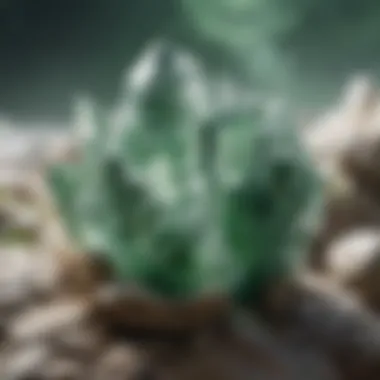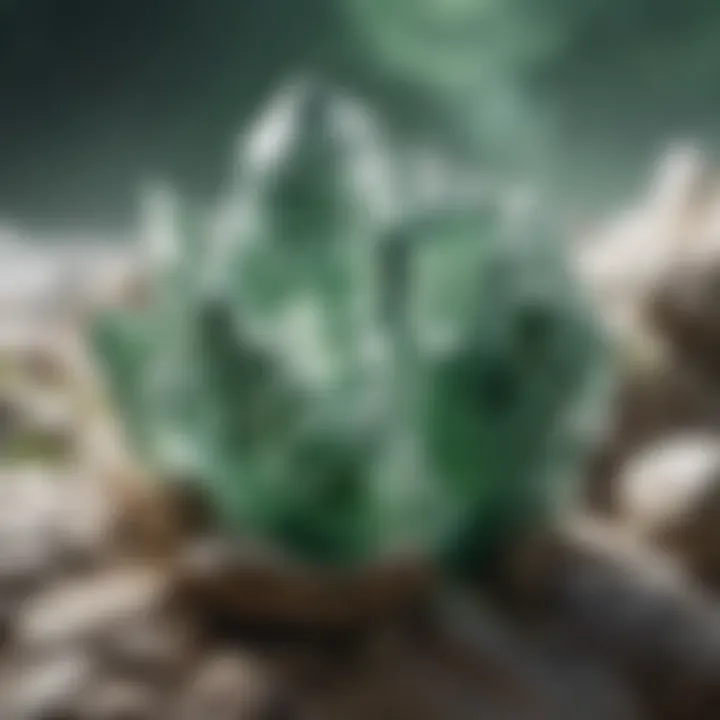Light Green and White Crystals: Characteristics and Importance


Intro
The world of crystals is expansive and diverse, with each type flaunting its own colors, shapes, and characteristics. Among these, light green and white crystals stand out not only for their aesthetic appeal but also for their geological and cultural significance. These crystals are often sought after by both collectors and enthusiasts, owing to their unique formation processes and captivating properties.
Light green crystals typically emanate a sense of tranquility and renewal, often associated with natural growth. Think of the lush forests or the first signs of spring. On the other hand, white crystals embody purity and clarity, representing potential and truth. Together, these colors create a remarkable palette of natural artistry that harks back to the Earth’s rich history. This article will peel back the layers of their significance and utility, shedding light on their unique features and the fascinating stories they tell.
For rock and fossil collectors, understanding these crystals goes beyond mere aesthetics. It involves grasping their identification methods, historical backgrounds, and the geological processes that lead to their formation. Let’s delve further into this captivating subject with our first section.
Characteristics of Light Green and White Crystals
Understanding the characteristics of light green and white crystals is essential for both enthusiasts and collectors. These attributes not only define their beauty but also influence their utility and desirability in various contexts, from jewelry to healing practices. Delving into aspects like color variations, transparency levels, and hardness helps gauge their unique appeal and practical applications, guiding collectors in their pursuits.
Physical Properties
Color Variations
Color plays a fundamental role in the allure of light green and white crystals. These hues can range from soft, pastel greens reminiscent of fresh spring leaves to vibrant shades that evoke the depths of a lush landscape. White crystals may present themselves as pure, snowy specimens or take on a slightly milky appearance that adds character.
One key characteristic of these color variations is how they resonate with collectors. For example, the subtlety of light green can evoke feelings of tranquility and nature, while white crystals often symbolize clarity and purity. Such emotional connections bolster their value as aesthetic pieces. However, these colors can be influenced by impurities or environmental factors during formation, making specific hues rarer than others.
This variation opens up a treasure trove of options for those seeking to integrate these crystals into their collections or decoration. Ultimately, the aesthetic appeal of color in light green and white crystals cannot be understated; it sets the stage for their desirability.
Transparency Levels
Transparency is another hallmark feature of light green and white crystals. These crystals can be perfectly clear, allowing light to dance through them, or they may exhibit varying degrees of cloudiness. This transparency affects how light interacts with each crystal, adding depth and allure.
Collectors often find transparent stones especially appealing because they reveal internal structures and colors. For instance, a transparent light green crystal can create mesmerizing effects under sunlight, enhancing its beauty. However, factors such as inclusions or brittleness can limit optical brilliance in some specimens, risking their desirability. Thus, managing transparency effectively becomes crucial for both collectors and dealers as it impacts perceived value significantly.
Hardness and Durability
The hardness and durability of these crystals matter greatly, particularly for those who plan to use them in jewelry or everyday items. Measured on the Mohs scale, many light green and white crystals showcase varying levels of resilience, from the softer varieties like calcite to the exceedingly tough like quartz.
This characteristic is beneficial since it can guide a collector's choices based on intended use. For example, more resilient crystals like jade can withstand daily wear, making them preferable for jewelry pieces. In contrast, softer crystals may require more delicate treatment and careful handling, thus limiting their functionality in some areas.
The unique feature in the hardness of these crystals is that it fosters a spectrum of uses, from ornamental displays to practical applications. Balancing beauty and durability becomes a guiding principle for collectors as they evaluate potential acquisitions.
Chemical Composition
Common Elements Found
The chemical composition of light green and white crystals contributes significantly to their distinct properties. Elements like silica, aluminum, and calcium are common amongst these crystals, each imparting unique characteristics that matter to collectors.
For instance, quartz, frequently found in light green forms, is made primarily of silicon dioxide, which leads to its remarkable clarity and durability. Meanwhile, the presence of potential impurities can introduce those beautiful color variations that define many of these crystals. Understanding this composition empowers collectors to make informed choices based on quality and rarity.
Moreover, recognizing common elements aids in identifying authentic specimens. As such, familiarity with chemical makeup is invaluable to serious collectors looking to enhance their collections thoughtfully.
Crystal Structure and Classification
Diving into the crystalline structure and classification offers deeper insights into the characteristics of these crystals. Many light green and white crystals belong to classes such as hexagonal or orthorhombic, dictating their physical manifestations and behaviors.
This structural knowledge can enhance an appreciation for their elegance and complexity. For instance, the six-sided symmetry of quartz can lead to striking formations and variations—contrasting against the typically more irregular structure of other minerals. Such classifications help connect the crystals to their geological origins, making them not just decorative pieces but also stories of earth’s processes.
Appreciating these structural traits is essential for collectors as it aids in distinguishing genuine specimens from imitations, further enriching the collecting experience.
Formation and Geological Context


Understanding the formation and geological context of light green and white crystals is crucial for both collectors and enthusiasts. It provides insights into how these stunning minerals come into existence, linking their chemical makeup to the dynamic processes of our planet. The genesis of these crystals reveals stories of ancient environments, raw natural forces, and the intricate balance of Earth’s systems.
Mineral Formation Processes
Metamorphism
Metamorphism is a fascinating process wherein existing minerals are transformed under intense heat and pressure. This gradual but impactful change often gives birth to attractive crystals in various shades, including light green and white. For instance, when schist or gneiss rock undergoes metamorphism, mica and quartz can re-crystallize into striking garnets or even jadeite, showcasing their vivid hues.
A key characteristic of metamorphism is its ability to rotate and align minerals, leading to unique textural features. By understanding this, collectors can better appreciate the natural artistry found in metamorphic rocks. However, a possibly disadvantageous aspect is that the conditions required for metamorphism can be restrictive, often limiting the locations where these crystals can be found.
Igneous Processes
Igneous processes, on the other hand, result from the cooling and crystallization of magma or lava. Light green crystals, commonly found in certain types of basalt or granite, often owe their rich tones to the mineral olivine.
The notable property of igneous processes is their rapid formation of crystals, which can produce stunning examples that are highly sought after in collections. This swiftness can be a double-edged sword since it could sometimes lead to less-perfect crystals, but nonetheless, it contributes significantly to the varied aesthetic spectra available.
Sedimentary Origins
Sedimentary origins present yet another intriguing facet of the light green and white crystal formation. Through the gradual accumulation of sediments, minerals like calcite and quartz often form visually appealing crystals, sometimes layered in a manner that enriches their visuals. A prime example includes the formation of celestine crystals, which often exhibit subtle hues.
A key characteristic of these sedimentary processes is the time taken for formation, which can result in intricate patterns synonymous with geological history. While these processes can produce breathtaking findings, they might not yield crystals as durable as those formed through metamorphic or igneous processes, which could be an important consideration for collectors.
Geological Distribution
Major Geological Regions
The distribution of light green and white crystals across major geological regions offers a treasure map of sorts for collectors. Regions such as the Appalachian Mountains or the Sierra Nevada showcase a delightful blend of metamorphic and igneous formations, leading to diverse crystal varieties.
A critical aspect to note here is the relationship between geological features and crystal types. For example, volcanic activity in regions like the Pacific Ring of Fire introduces crystalline varieties that are otherwise rare. However, newcomers might find traversing these areas challenging, given the often rugged terrain.
Fossil Connections
Lastly, fossil connections to light green and white crystals add another layer to their significance. The presence of certain fossils often indicates the surrounding mineral compositions and can thus guide collectors to targeted locations. A great characteristic of these connections is that they bridge paleontology and mineralogy, enriching both fields.
Some fossilized minerals can also help collectors understand the environmental conditions under which the crystals formed, giving them a historical perspective. One must be cautious though, as not all fossil connections lead to fruitful findings—some regions are more productive than others.
In sum, the formation and geological context of light green and white crystals not only uncover the processes behind their creation but also orient collectors and enthusiasts toward regions that hold these beautiful natural gems. Understanding these foundational aspects invariably elevates the experience of crystal collecting, turning it into a journey through time and nature.
Significance in Collecting Practices
Understanding the significance of light green and white crystals holds a prominent place in the realm of mineral collection. As collectors delve into the world of geology, these specific crystals hold unique allure due to their characteristics and meanings. The fascination surrounding these stones isn’t just about their physical beauty; it also encompasses the stories woven into their existence and the broad cultural significance attributed to them. Various factors such as rarity, aesthetic qualities, and market trends all play an integral role in shaping a collector's interest and pursuit.
Collector Appeal
Rarity and Value
Rarity and value often go hand in hand when it comes to crystals. Light green and white crystals, while found in various locations, can sometimes be elusive depending on their specific type. For instance, a rare variety of white crystal like Calcite could fetch a pretty penny due to its limited availability and high demand among enthusiasts. The rarity aspect enhances their allure, making these crystals cherished possessions rather than mere decorations.
In many ways, the rarity of a crystal directly correlates with its value. Collectors often see the acquisition of these stones as not just a hobby but an investment. The unique feature here is that the rarity isn't solely based on the physical attributes of the crystal but can also be influenced by market demand and collector trends. Increased interest may lead to a spike in prices, revealing a double-edged sword: while rarity can elevate the value, finding the right buyers willing to pay the asking price can sometimes prove challenging.
Aesthetic Considerations
The visual appeal of light green and white crystals also plays a crucial role in attracting collectors. Their soft hues offer a calming presence that can transform a mundane space into a tranquil sanctuary. The key characteristic here is the variety of shapes and formations these crystals can take, showcasing nature's artistry.
When selecting crystals for personal collections or display, aesthetic considerations often outweigh other factors. A well-formed piece of green fluorite, for example, could bring striking beauty while also serving as an alluring conversation starter. However, the beautiful appearance can sometimes mislead collectors about a crystal's actual value, especially if they focus more on looks than rarity or authenticity.


Market Trends
Popular Crystals Among Collectors
Among the light green and white crystals, certain ones command more attention based on collector popularity. For example, Amethyst, typically known for its purple shades, has light variants that attract collectors aiming to diversify their holdings. Collectors find such popularity appealing, as it often translates to a rich market for buying, trading, and even selling.
The trend here is not only about aesthetics but also about connection—collectors often share their personal experiences with particular stones, creating a sense of community. The risk, however, lies in the over-saturation of certain collections, leading to potential drops in value if market interest wanes. Those in the game need to keep their fingers on the pulse of shifts in popular demand to maintain their collecting prowess.
Emerging Trends in Collectibles
Emerging trends in collectible markets are continually shaping what’s sought after. As technology and society evolve, so do the preferences of collectors, leading to a surge in interest for crystals that resonate with modern values such as sustainability and wellness.
For instance, crystals with purported healing properties or connected to astrological phenomena have gained significant traction, fueling interest in collecting. With platforms like Reddit and specialized Facebook groups dedicated to these discussions, collectors can share insights and recommendations, further shaping preferences.
Nevertheless, while these emerging trends can put certain types of crystals in the spotlight, they also present a challenge: staying informed to avoid impulsive purchases. Collectors should tread cautiously, aligning their collecting goals with current market dynamics while ensuring that their personal appreciation remains intact.
Identification Techniques
Understanding the identification techniques used for light green and white crystals is crucial for both collectors and enthusiasts. Accurately distinguishing these crystals not only aids in proper categorization but also enhances appreciation for their unique qualities. In this section, various methods of identification will be discussed, each presenting its own benefits and pitfalls.
Visual Identification
Color Factors
When it comes to identifying light green and white crystals, color is often the first cue one may notice. The different shades of green can vary widely based on the mineral composition. For instance, a pale-green crystal like fluorite can often be confused with a more vibrant green variety of tourmaline.
The key characteristic of color is how it immediately resonates with observers, drawing them towards certain specimens. Color attracts attention and can evoke powerful emotions, making it a popular aspect for both novice and seasoned collectors.
However, relying solely on color might be misleading. Environmental factors or the presence of impurities could alter a crystal's appearance. For light green shades, variations in lighting can also lead to vastly different perceptions. Thus, color identification is beneficial but should not be the only factor in determining the authenticity of a crystal.
Surface Characteristics
Surface textures serve as another invaluable identifying trait. The feel and look of the surface can range from smooth to rough, providing clues about the crystal's formation process. For instance, a white quartz crystal often displays a glassy sheen when polished, differentiating it from other opaque varieties.
Surface characteristics are popular because they not only help in identifying the mineral type but can also hint at the crystal's history and formation environment. The unique feature of these textures is that they often tell a story of their geological journey. However, factors such as weathering or artificial polishing might skew the original surface, sometimes complicating the identification process.
Scientific Methods
Spectroscopy
Spectroscopy is a scientific method that examines how a crystal interacts with light. By analyzing the light absorbed and emitted by a crystal, one can determine its constituents and molecular structure. This is particularly beneficial for light green and white crystals, as subtle differences in composition can lead to distinct spectral signatures.
The key characteristic of spectroscopy is its precision. Unlike visual methods that can be subjective, this technique offers a quantitative analysis that leaves little room for doubt. The unique advantage of this method makes it an essential tool in laboratories and for advanced collectors who seek to verify the authenticity of their specimens.
X-Ray Diffraction Techniques
X-ray diffraction is another sophisticated method used in crystal identification. This technique analyzes the pattern created when X-rays are dispersed by the crystal lattice. It provides detailed information about the crystal structure, helping to classify minerals accurately.
The strong point of X-ray diffraction lies in its ability to reveal atomic arrangements, making it a favorite for mineralogists and researchers. However, it requires specialized equipment and expertise, making it less practical for casual collectors. Still, its ability to categorize crystals with remarkable accuracy is unrivaled, cementing its place in modern mineral analysis.
Care and Preservation
The preservation of light green and white crystals holds paramount importance, particularly for both aesthetics and value. Understanding how to care for these delicate minerals ensures their longevity and vibrancy, appealing to collectors and enthusiasts alike. Well-preserved crystals not only maintain their beauty but also contribute to their overall market value. Neglect can lead to irreversible damage, be it through scratches, discoloration, or brittleness. Therefore, adopting effective care and preservation practices is essential for anyone invested in these stunning geological wonders.
Storage Recommendations


Optimal Conditions
Creating the right environment for light green and white crystals significantly affects their condition over time. These minerals generally thrive in dry places with stable temperatures. Extreme fluctuations can cause stress fractures or cloudiness, rendering even the most exquisite specimen less appealing. For instance, keeping them away from direct sunlight is wise, as prolonged exposure can fade their colors. A dark, cool drawer lined with cotton is an ideal storage option. This practice not only protects against physical damage but also minimizes moisture exposure, which can promote mold growth.
Protective Measures
Implementing protective measures while storing these crystals is another layer of defense worth discussing. Using padded boxes or dedicated display cases can shield them from unintentional contact or falls, both of which could lead to breaks or surface scratches. Additionally, interleaving delicate specimens with soft cloth can prevent them from scratching one another, preserving their integrity and aesthetic value. The key here is to maintain a balance; while protection is vital, ensure that airflow isn’t completely stifled to prevent moisture buildup.
Cleaning Practices
Regular, appropriate cleaning ensures that light green and white crystals remain in pristine condition. Dust accumulation not only detracts from their beauty but can also lead to damage in the long run if not properly addressed.
Material-Specific Guidelines
Different types of crystals require tailored cleaning methods. For example, while quartz varieties can often tolerate water and gentle soap, more fragile stones like calcite need a dry brush approach to remove dust without causing harm. Understanding the material-specific guidelines for cleaning enhances the longevity of the specimens and assures their visual appeal. Always research or consult trusted sources on the appropriate methods for your particular crystals to avoid unintentional damage.
Safe Cleaning Chemicals
Using harsh chemicals can lead to irreversible damage to light green and white crystals. Instead, opting for safe cleaning chemicals is a prudent approach. Solutions like vinegar and water in minimal concentrations can work wonders, ensuring a thorough cleanse without compromising the stone’s integrity. It’s also wise to avoid anything acidic or abrasive. The beauty of this methodology is that it encourages regular upkeep without fraying nerves over potential damage. Always test any cleaning solution on a small, inconspicuous areas before proceeding.
Proper care and preservation not only maintains the beauty of light green and white crystals but can dramatically enhance their market value over time.
In summary, adopting effective care and preservation methods is key in safeguarding the vibrancy of crystals while elevating their appeal to collectors. Thoughtful storage, protective measures, and precise cleaning practices play crucial roles in this endeavor.
Cultural Impacts
Understanding the cultural impacts of light green and white crystals uncovers a rich tapestry of historical significance and modern interpretations that resonate deeply with both collectors and enthusiasts. These crystals have not only served as decorative objects but have also played pivotal roles in spiritual practices and artistic expressions throughout history. By exploring the nuances of their cultural relevance, we can appreciate how these natural wonders shape human experiences, beliefs, and creativity.
Historical Perspectives
Use in Ancient Cultures
Throughout history, ancient civilizations utilized light green and white crystals for various purposes, from adornment to spiritual rituals. For instance, jade, known for its soothing green hues, was highly esteemed in Mesoamerican cultures—Aztecs and Mayans often used it to craft ceremonial masks and jewelry, believing it held protective properties and connections to the afterlife.
The distinct feature of these crystals in ancient practices lies in their perceived metaphysical properties. Such crystals were thought to channel healing energies, serving as talismans in many cultures. This powerful association with wellness underscores their prolonged appeal, proving beneficial not just aesthetically but also in holistic practices.
However, it’s crucial to recognize the disadvantages that may arise from such heavy reliance on crystals for spiritual practice. Misunderstandings about their capabilities could lead to unrealistic expectations, influencing the way individuals approach healing processes in modern contexts.
Symbolic Representations
Symbolism surrounding light green and white crystals extends beyond their immediate beauty. In many traditions, light green crystals symbolize growth, renewals, and prosperity, while white crystals often stand for purity and tranquility. For example, in middle-eastern cultures, the white opal is regarded as a stone of harmony, bridging gaps between spiritual and material worlds.
The key characteristic of this symbolism enhances their importance within various cultural narratives. By embodying ideas such as peace and vitality, these crystals infuse cultural artifacts with deeper meanings, influencing art, literature, and daily lives. However, the risk of over-commercialization can sometimes distort these representations, diminishing their authentic cultural essence.
Modern Interpretations
Artistic Expressions
In contemporary art, light green and white crystals emerge as popular materials. Artists often incorporate them into sculptures, jewelry, and installations, highlighting their lustrous textures and colors. This trend allows creators to explore not only the physical beauty but also the emotional resonance of these crystals, which embody natural elegance and human connection.
One unique aspect of using these crystals in art is their ability to evoke emotional responses. For instance, a piece featuring amethyst and jade may stir feelings of calm or stimulate contemplation. This duality enriches the narrative behind artworks, creating a bridge between viewer and creator.
Yet, there can be challenges in balancing aesthetics and authenticity, as some creators may prioritize trends over meaningful representation. This raises questions about the cost of creativity against the backdrop of commercial success.
Influence on Popular Culture
Light green and white crystals also significantly impact modern pop culture, appearing in films, music, and fashion. For instance, a character in a well-known TV series wears a stunning emerald pendant, sending waves of popularity through collectors chasing similar pieces. Here, crystals become not just adornments but cultural icons, shaped by the narratives constructed around them.
The key characteristic of this influence is its ability to continually revive interest in these crystals among broader audiences, allowing them to resonate beyond niche communities. Fans of popular culture may find themselves attracted to these stones, leading to increased engagement in the world of collecting.
Nonetheless, a cautionary note persists: the commodification of crystals can dilute their cultural significance, and there's a tendency to approximate true cultural meanings to fit commercial narratives, risking the authenticity many collectors seek.
Understanding the cultural impacts helps us appreciate the deep connections that light green and white crystals foster across time, bridging the ancient and the contemporary while inviting all to explore their meanings.



